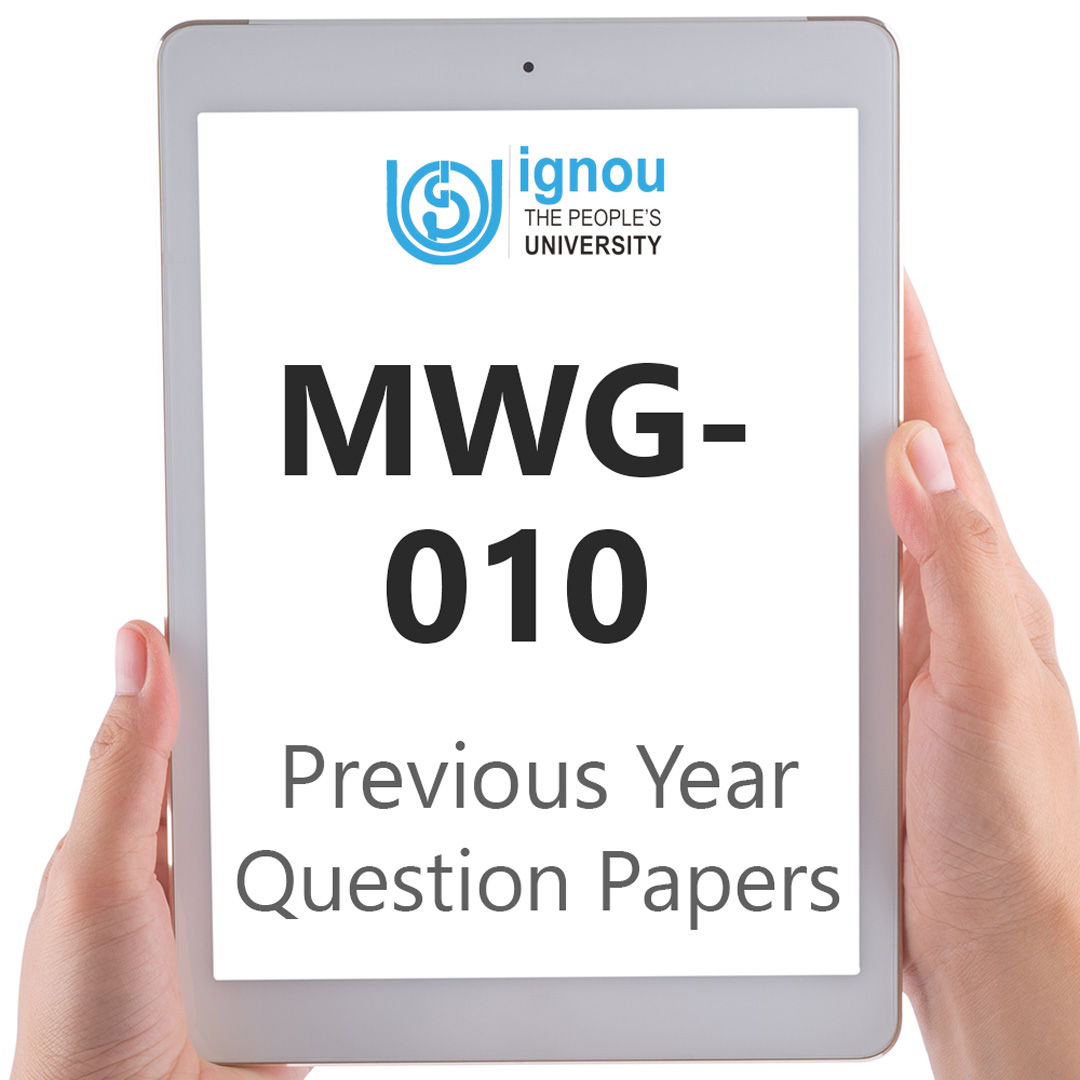If you are looking for MWG-010 IGNOU Solved Assignment solution for the subject Women & Political Process, you have come to the right place. MWG-010 solution on this page applies to 2022-23 session students studying in MAWGS courses of IGNOU.
MWG-010 Solved Assignment Solution by Gyaniversity
Assignment Code: MWG 010/AST/TMA-2022
Course Code: MWG-010
Assignment Name: Women and Political Process
Year: 2022
Verification Status: Verified by Professor
Attempt any two of the following Long Answer questions (50 marks each)
1. Read Block 2, Unit 3, ‘Women and Partition’. Analyze the debates related to the Unit in the context of women’s body and violence by giving any examples.
Ans) Violence was a big part of the Partition. Even though it's been more than 60 years, 1947 is still a traumatic event in the history of the subcontinent, and it's still important in the present day. Gyanendra Pandey says in his book "Making of the Community" (2001) that violence helps "make the community" and "make the subject of history." The happiness of becoming an independent country was mixed with the pain of being split up and the violence that came with it. This particular parting has a unique effect on the lives of both countries. The important event of partition is where the study of how India became a country and the political economy of India after it got its independence should begin.
There is a lot of writing about the issue of partition, and many people are interested in it. As we study the history of partition, we try to figure out what happened in 1947. On the one hand, books about the political history of partition tell us about the arguments between different political groups and leaders, such as the Congress and the Muslim League, or about the role of the British in dividing this area. On the other hand, there are records of violence, being moved, and a lot of people moving. But, as Veena Das (1995), Urvashi Butalia (1998), Ritu Menon (1999), and others have pointed out, the millions of people who were left out of the discussion of partition were the separated families, whose anxious wait for the return of a lost member formed the basis of tragedy that replaced the violence of bereavement. The "written history of partition" never said how they got their lives back together. So, feminist historians have questioned what it was like for the people who suffered during the process of partition, and their writings have become known as the "historiography of the partition."
Ritu Menon and Kamala Bhasin wrote in 1998 that "feminist historiography of the partition" is hard to find in "political histories of partition." Feminist history is important because it helps us understand the voices of women that were not heard. It also shows how the female body is used by the nation, family, and community to try to build "their" identities. Also, it helps us rewrite the history of how women and men were treated during partition.
Official records, parliament debates, private papers, literary writings, treaties, political histories, memoirs, and analytical writings are all types of literature that have to do with the Partition. By taking a close look at these works, we can better understand how complicated the event was. People say that books, autobiographies, oral histories, and other sources are important ways to learn about the partition because they tell a different storey than the official one. The stories that feminist writers collected showed that no storey was complete or all-encompassing (Bhasin and Menon 1998). The many interviews with women who were "victims" of partition show that it would be hard to describe the "single experience" of partition because it was a "multifaceted experience" that was tied together by tragedy. Their stories show how women, their country, and their communities are all connected.
On June 3, 1947, it was announced that the "partition of India" would be planned, but the borders were not given. In the end, the Boundary Commission decided to draw the line. First, the talk about the partition and the official announcement of it caused many families to move from one place to another. After the Noakhali riots in November 1946, people talked about how to handle the migration by setting up a way for people to move safely and stop violence against the minority group. Violence broke out in different parts of the continent, which made people want to move even more. Most people who were moving did so in groups, and they felt like they were being trapped.
Many women and children were taken or killed, or they were left without parents. Eight to ten million people were thought to have come from Punjab and Bengal. Violence was everywhere. Still, it was very organised and planned. Both sides said that political leaders from the Muslim League and the Jamaat, as well as those from the Hindu Mahasabha or the Rashtriya Swayam Sevak Sangh, were involved. Self-defense gave people the right to use violence. But in a place where there was so much chaos, economic factors also played a big role.
3. Critically read Block 4, Unit 2 and Unit 3. Explain the relationship between women and election with the help of examples.
Ans) The word "political participation" can mean a lot of different things. It has to do with more than just the "Right to Vote." It also has to do with the decision-making process, political activism, political awareness, etc. To stop women from being treated unfairly in politics, the Indian government has set aside seats in local governments for women. In India, women have been president, prime minister, and chief minister of many different states. Since the 1960s, Indian voters have sent women to many state legislatures and to the national parliament. India's Constitution sets up a parliamentary system of government and gives its citizens the right to be elected, freedom of speech, freedom to gather and form groups, and the right to vote. The Constitution of India tries to get rid of gender inequality by making it illegal to treat people differently based on their class or sex, outlawing human trafficking and forced labour, and giving women a chance to run for office.
According to Pamela Paxton and Melanie M.Hughes, "women are underrepresented in politics." This is clear from the fact that "the average number of women in national parliaments around the world is only 20%." They also say that the way women have been shown has changed in the last hundred years. These scholars compare it to a time when women didn't have the right to vote anywhere in the world. Because of this, Pamela and Melanie say that women are still underrepresented. But they say that "the growth of women's political power is one of the most important trends of the last 100 years."
Monodeep Daniel says that the Indian leadership is part of a "social and cultural reality of exclusion, expulsion, and exploitation." Daniel thinks that Pandita Ramabai, a social reformer from Maharashtra, is a good example of the "managerial model of leadership." In other words, Pandita Ramabai is the managerial model of leadership because she started Sarada Sadan for the most disadvantaged people, such as women living alone, children, and so on. Scholars like Amartya Sen have looked at freedom as something that women get from "paid work," which allows them to move out of the home. Also, it's important to keep in mind that the "decision-making process" is linked to "authority," which is based on "cultural legitimization." Clara Zetkin said, "We women protest strongly against putting limits on what women can do." We don't want our cause to be different from that of the working class as a whole.
People need to look into the social and political factors that affect how much power women have. Radheshyam Jadhav says that the 73rd Amendment Act to the Indian Constitution in 1993 brought about a three-tier system of village and district government. It made sure that women had a place in the Gram Panchayats. Jadhav says that this can be seen as the "first step toward women's leadership at the grassroots level." "After taking over their villages as Sarpanches, hundreds of uneducated women in Maharashtra have led a silent revolution that has changed the way rural development works," it is said. A paradigm shift has made health and sanitation issues one of the most important parts of rural development.
For example, sarpanches like Sunita Lohar learned how the lack of toilets affected women's health. She says, "I'm a woman, too." So, I could see what they were going through. As soon as she became sarpanch, she built toilets for the village. She said, "Our village didn't have a single toilet." Even the wealthy families didn't think that having a toilet was worth the money. So, women had to wait until late at night or early in the morning to go to the bathroom. We couldn't poop or pee in the open during the day because men were working in the fields. It was horrible. Jadhav said that men did not realise how important toilets were. But as the sarpanch of the Borne village, Lohar made sure that all of the homes in the area had toilets.
Amar Pal Singh Verma says that Sarpanch Krishna Chaudhary has always fought against social forces that make it hard for girls to go to school. In order to understand Krishna Chaudhary's struggles as a sarpanch, you have to look at the bigger picture of society's problems. It is known that Krishna Chaudhary wants girls to go to school so that the awful practise of child marriage will end. Chaudhary says that education is a unique chance for girls that is taken away as soon as they get married. So, I pay a lot of attention to their education, because if they get an education, their homes will change, too. For example, she gave money so that the girls' school could have a water tank. She also helped get three Anganwadis up and running in the village of Rajasthan as well. Krishna Chaudhary said, "Education is the most important thing." Education is very helpful. People in my village are beginning to realise this is true. What else could be better?'
Sarpanch Archana Jatkar's decision to run for office is a sign of women's political ambition that challenges the idea that politics is only for men. During her time in school, she has voted in college elections. Mahesh Rajaguru says that her grandmother was against her going into politics, so she had to wait until she got married to do so. After she got married, her in-laws and husband helped her get involved in politics. So, women's political goals are caught in a complex web of family values. As a sarpanch from Maharashtra, she focused on education and water as the most important issues for the poorest communities. Jatkar argued that "one needs to be actively involved in the governance process so that one can reach a position of authority before addressing problems at the village level." She also says, "A village is like a family, and the Sarpanch is in charge as the head of the family." A Sarpanch must answer to the people if he or she is to do a good job.
Some women, like Sampat Pal, have fought for women's rights without running for office. Sampat Pal says, "I'm not going into politics because I want to help people. We will keep doing good work so that the government doesn't get used to us. The Gulaabi Gang or Pink Sari Brigade is what people call them. This group focuses on how terrible it is when violence is based on caste or gender. Pal is in charge of the group, which is made up of women from different castes. Women activists talk with each other and talk about their plans. People say that activists step in when the government isn't willing to stop bad things that happen to women.





